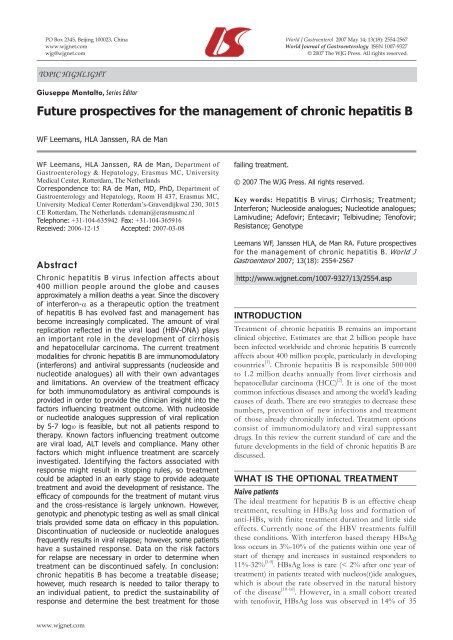18 - World Journal of Gastroenterology
18 - World Journal of Gastroenterology
18 - World Journal of Gastroenterology
Create successful ePaper yourself
Turn your PDF publications into a flip-book with our unique Google optimized e-Paper software.
PO Box 2345, Beijing 100023, China <strong>World</strong> J Gastroenterol 2007 May 14; 13(<strong>18</strong>): 2554-2567<br />
www.wjgnet.com <strong>World</strong> <strong>Journal</strong> <strong>of</strong> <strong>Gastroenterology</strong> ISSN 1007-9327<br />
wjg@wjgnet.com © 2007 The WJG Press. All rights reserved.<br />
TOPIC HIGHLIGHT<br />
Giuseppe Montalto, Series Editor<br />
Future prospectives for the management <strong>of</strong> chronic hepatitis B<br />
WF Leemans, HLA Janssen, RA de Man<br />
WF Leemans, HLA Janssen, RA de Man, Department <strong>of</strong><br />
<strong>Gastroenterology</strong> & Hepatology, Erasmus MC, University<br />
Medical Center, Rotterdam, The Netherlands<br />
Correspondence to: RA de Man, MD, PhD, Department <strong>of</strong><br />
<strong>Gastroenterology</strong> and Hepatology, Room H 437, Erasmus MC,<br />
University Medical Center Rotterdam’s-Gravendijkwal 230, 3015<br />
CE Rotterdam, The Netherlands. r.deman@erasmusmc.nl<br />
Telephone: +31-104-635942 Fax: +31-104-365916<br />
Received: 2006-12-15 Accepted: 2007-03-08<br />
Abstract<br />
Chronic hepatitis B virus infection affects about<br />
400 million people around the globe and causes<br />
approximately a million deaths a year. Since the discovery<br />
<strong>of</strong> interferon-α as a therapeutic option the treatment<br />
<strong>of</strong> hepatitis B has evolved fast and management has<br />
become increasingly complicated. The amount <strong>of</strong> viral<br />
replication reflected in the viral load (HBV-DNA) plays<br />
an important role in the development <strong>of</strong> cirrhosis<br />
and hepatocellular carcinoma. The current treatment<br />
modalities for chronic hepatitis B are immunomodulatory<br />
(interferons) and antiviral suppressants (nucleoside and<br />
nucleotide analogues) all with their own advantages<br />
and limitations. An overview <strong>of</strong> the treatment efficacy<br />
for both immunomodulatory as antiviral compounds is<br />
provided in order to provide the clinician insight into the<br />
factors influencing treatment outcome. With nucleoside<br />
or nucleotide analogues suppression <strong>of</strong> viral replication<br />
by 5-7 log10 is feasible, but not all patients respond to<br />
therapy. Known factors influencing treatment outcome<br />
are viral load, ALT levels and compliance. Many other<br />
factors which might influence treatment are scarcely<br />
investigated. Identifying the factors associated with<br />
response might result in stopping rules, so treatment<br />
could be adapted in an early stage to provide adequate<br />
treatment and avoid the development <strong>of</strong> resistance. The<br />
efficacy <strong>of</strong> compounds for the treatment <strong>of</strong> mutant virus<br />
and the cross-resistance is largely unknown. However,<br />
genotypic and phenotypic testing as well as small clinical<br />
trials provided some data on efficacy in this population.<br />
Discontinuation <strong>of</strong> nucleoside or nucleotide analogues<br />
frequently results in viral relapse; however, some patients<br />
have a sustained response. Data on the risk factors<br />
for relapse are necessary in order to determine when<br />
treatment can be discontinued safely. In conclusion:<br />
chronic hepatitis B has become a treatable disease;<br />
however, much research is needed to tailor therapy to<br />
an individual patient, to predict the sustainability <strong>of</strong><br />
response and determine the best treatment for those<br />
www.wjgnet.com<br />
failing treatment.<br />
© 2007 The WJG Press. All rights reserved.<br />
Key words: Hepatitis B virus; Cirrhosis; Treatment;<br />
Interferon; Nucleoside analogues; Nucleotide analogues;<br />
Lamivudine; Adefovir; Entecavir; Telbivudine; Ten<strong>of</strong>ovir;<br />
Resistance; Genotype<br />
Leemans WF, Janssen HLA, de Man RA. Future prospectives<br />
for the management <strong>of</strong> chronic hepatitis B. <strong>World</strong> J<br />
Gastroenterol 2007; 13(<strong>18</strong>): 2554-2567<br />
http://www.wjgnet.com/1007-9327/13/2554.asp<br />
INTRODUCTION<br />
Treatment <strong>of</strong> chronic hepatitis B remains an important<br />
clinical objective. Estimates are that 2 billion people have<br />
been infected worldwide and chronic hepatitis B currently<br />
affects about 400 million people, particularly in developing<br />
countries [1] . Chronic hepatitis B is responsible 500 000<br />
to 1.2 million deaths annually from liver cirrhosis and<br />
hepatocellular carcinoma (HCC) [2] . It is one <strong>of</strong> the most<br />
common infectious diseases and among the world’s leading<br />
causes <strong>of</strong> death. There are two strategies to decrease these<br />
numbers, prevention <strong>of</strong> new infections and treatment<br />
<strong>of</strong> those already chronically infected. Treatment options<br />
consist <strong>of</strong> immunomodulatory and viral suppressant<br />
drugs. In this review the current standard <strong>of</strong> care and the<br />
future developments in the field <strong>of</strong> chronic hepatitis B are<br />
discussed.<br />
WHAT IS THE OPTIONAL TREATMENT<br />
Naïve patients<br />
The ideal treatment for hepatitis B is an effective cheap<br />
treatment, resulting in HBsAg loss and formation <strong>of</strong><br />
anti-HBs, with finite treatment duration and little side<br />
effects. Currently none <strong>of</strong> the HBV treatments fulfill<br />
these conditions. With interferon based therapy HBsAg<br />
loss occurs in 3%-10% <strong>of</strong> the patients within one year <strong>of</strong><br />
start <strong>of</strong> therapy and increases in sustained responders to<br />
11%-32% [3-9] . HBsAg loss is rare (< 2% after one year <strong>of</strong><br />
treatment) in patients treated with nucleos(t)ide analogues,<br />
which is about the rate observed in the natural history<br />
<strong>of</strong> the disease [10-16] . However, in a small cohort treated<br />
with ten<strong>of</strong>ovir, HBsAg loss was observed in 14% <strong>of</strong> 35

















